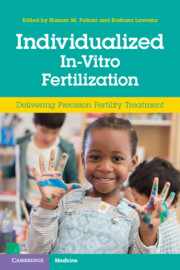Book contents
- Individualized In-Vitro Fertilization
- Individualized In-Vitro Fertilization
- Copyright page
- Contents
- Contributors
- Chapter 1 Individualized Ovarian Stimulation for Normal and High Responders
- Chapter 2 Individualized Ovarian Stimulation in Patients with Advanced Maternal Age and Premature Ovarian Aging
- Chapter 3 Individualized Oocyte Maturation
- Chapter 4 Individualized Luteal Phase Support
- Chapter 5 Individualized Management of Male Infertility
- Chapter 6 Individualized Fertilization Technique in the IVF Laboratory
- Chapter 7 Individualized Genetic Testing
- Chapter 8 Individualized Embryo Selection
- Chapter 9 Preparation for Optimal Endometrial Receptivity in Cryo Cycles
- Chapter 10 Individualized Immunological Testing in Recurrent Implantation Failure
- Chapter 11 Individualized Embryo Transfer
- Index
- Plate Section (PDF Only)
- References
Chapter 7 - Individualized Genetic Testing
Who Benefits?
Published online by Cambridge University Press: 12 February 2021
- Individualized In-Vitro Fertilization
- Individualized In-Vitro Fertilization
- Copyright page
- Contents
- Contributors
- Chapter 1 Individualized Ovarian Stimulation for Normal and High Responders
- Chapter 2 Individualized Ovarian Stimulation in Patients with Advanced Maternal Age and Premature Ovarian Aging
- Chapter 3 Individualized Oocyte Maturation
- Chapter 4 Individualized Luteal Phase Support
- Chapter 5 Individualized Management of Male Infertility
- Chapter 6 Individualized Fertilization Technique in the IVF Laboratory
- Chapter 7 Individualized Genetic Testing
- Chapter 8 Individualized Embryo Selection
- Chapter 9 Preparation for Optimal Endometrial Receptivity in Cryo Cycles
- Chapter 10 Individualized Immunological Testing in Recurrent Implantation Failure
- Chapter 11 Individualized Embryo Transfer
- Index
- Plate Section (PDF Only)
- References
Summary
The main aim of preimplantation genetic testing (PGT), which up until recently was known as preimplantation genetic diagnosis (PGD), is the identification of embryos that are free of inherited genetic conditions. PGT can therefore be considered as a treatment option for couples where one or both partners are at risk of transmitting such a condition to their offspring. Inherited genetic conditions can affect gene function or chromosome structure, and could either be present in families or arise de novo. PGT for inherited mutations affecting gene function is defined as PGT for monogenic disorders or PGT-M, whereas PGT for inherited chromosome rearrangements is termed as PGT for structural rearrangements or PGT-SR (). The selection and preferential transfer of healthy embryos could lead to the birth of babies who are free of the genetic disorder for which PGT was carried out, as well as potentially eradicate it from the family. Hence, PGT can be considered as an alternative form of prenatal diagnosis, with the added advantage that it avoids the termination of affected pregnancies.
- Type
- Chapter
- Information
- Individualized In-Vitro FertilizationDelivering Precision Fertility Treatment, pp. 79 - 95Publisher: Cambridge University PressPrint publication year: 2021



